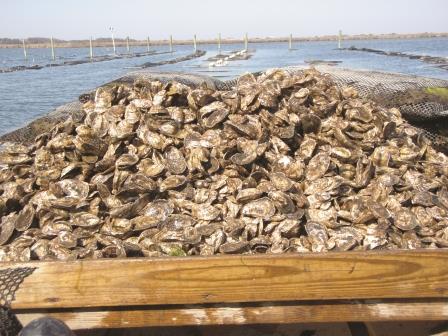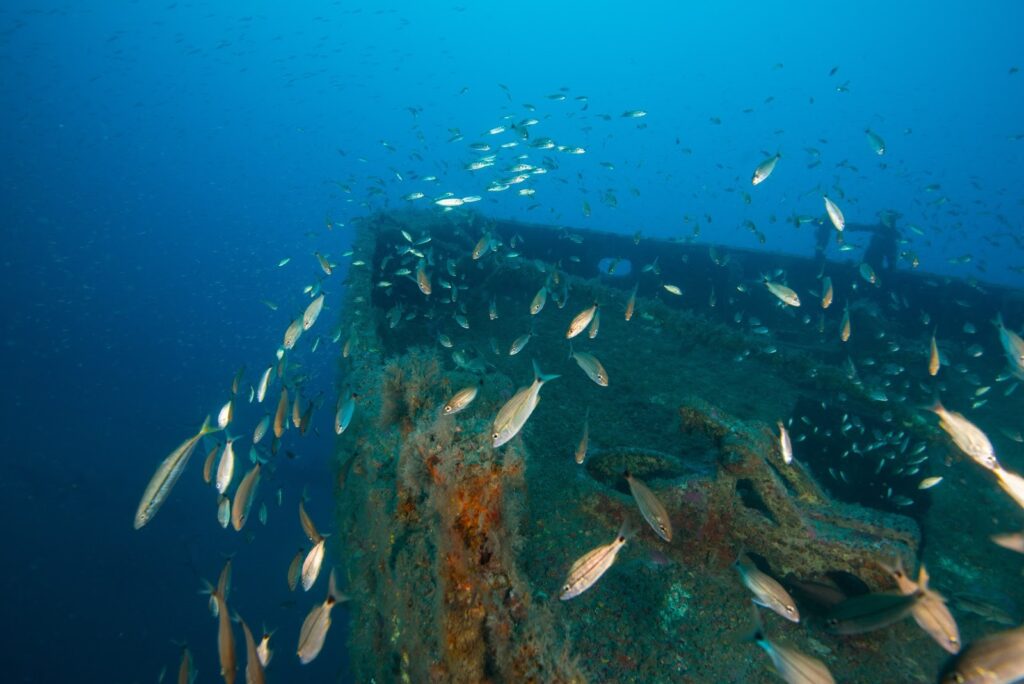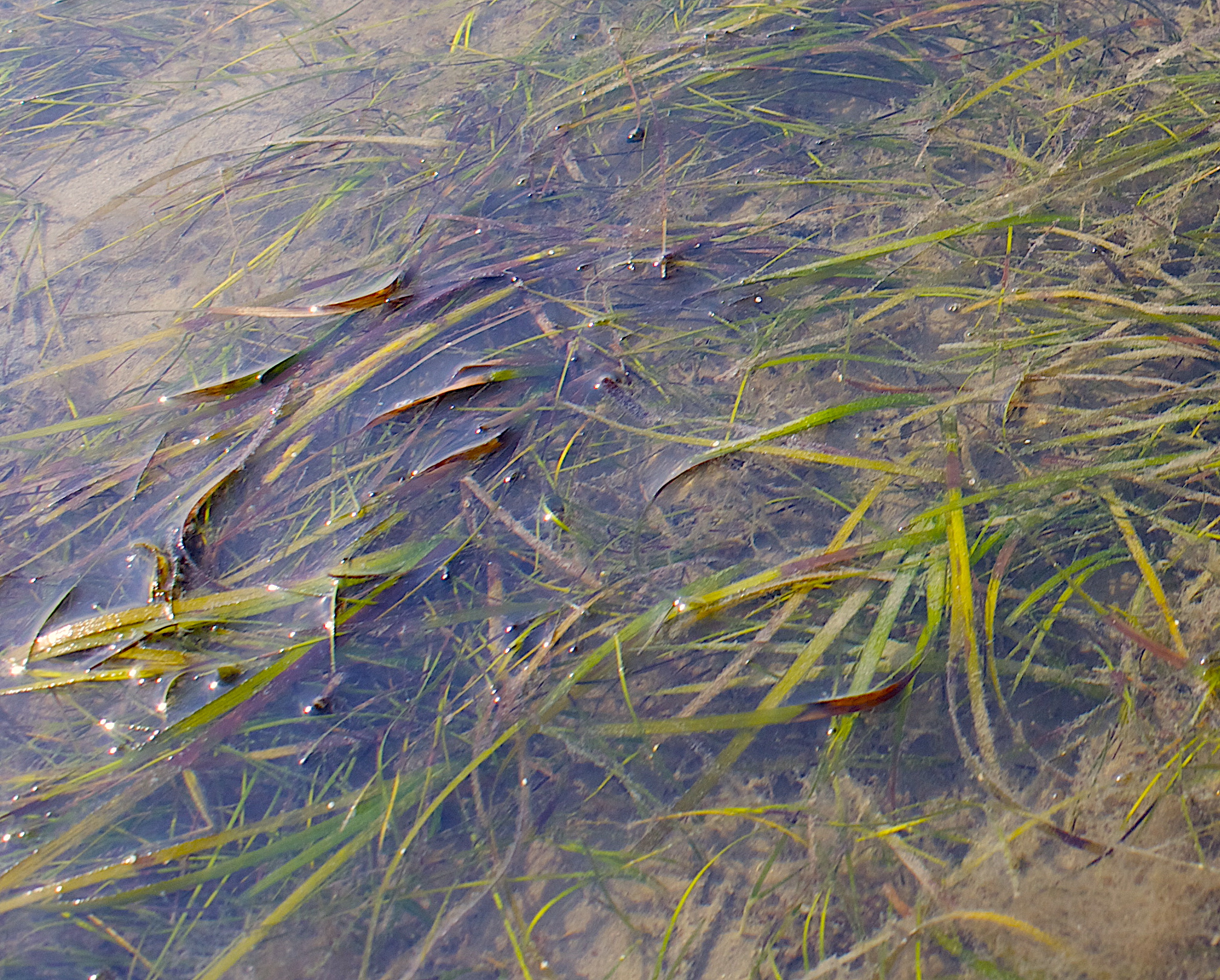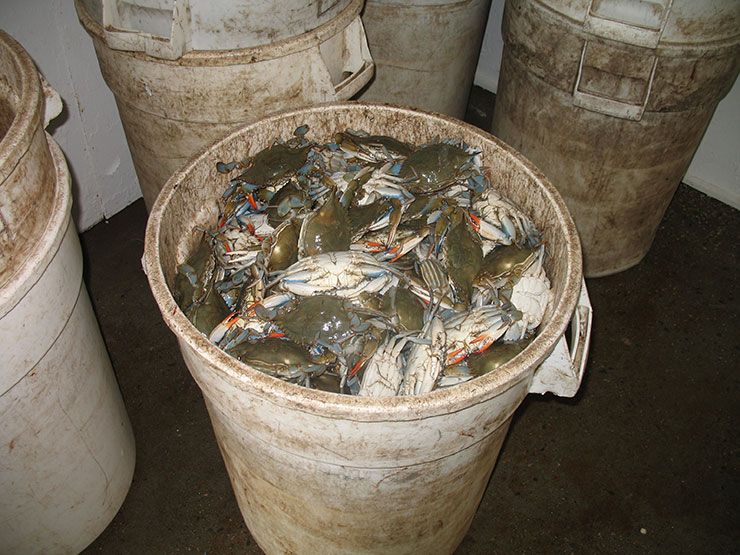Estuarine Research on the Half Shell

As the boat slips from the dock one early spring morning, there is a purposeful seriousness to the mission at hand, mixed with a hint of joy. It’s the first sunny, calm day in weeks, the kind of day that makes the long, cold mornings of winter fieldwork fade away in a heartbeat. Spring has arrived on the coast and it’s a beautiful morning to be on the waters overlooking Beaufort.
Michelle Brodeur, a graduate student at the University of North Carolina Chapel Hill’s Institute of Marine Sciences, and her team are off to monitor some of Brodeur’s research sites within the Rachel Carson component of the N.C. National Estuarine Research Reserve.
They have been spending the better part of six months wading among intertidal oyster reefs, conducting experiments and observing the system with the hope of gaining insight into the interactive effects of multiple stressors. Brodeur is curious about why some reefs thrive while others decline.

Brodeur’s research focuses on the macroalgae that cover the reefs for one-third of the year and how that may impact reef health. Heavy algal cover is a potential inhibitor to the success of a reef, yet little is understood about how the macroalgae interact with the oysters on these reefs.
As the boat leaves the dock, she notes, “Macroaglae cover reefs from around January through May. Currently we don’t see cover during the spawning and settlement periods of June through December.”
If algal mats were present during key times of an oyster reef’s lifetime — spawning and settlement — it could affect the continued health of the reef, she suggests.
Brodeur’s research is funded by a joint fellowship from North Carolina Sea Grant and NCNERR . The fellowship allows the agencies to strive toward common goals.
“The state’s coastal reserve program has important questions about the parcels it manages — questions that research can help answer,” observes Michael Voiland, North Carolina Sea Grant executive director. ” Given Sea Grant’s research and graduate education missions, joining in the fellow partnership with the reserve program made perfect sense.”
The Rachel Carson component is one of 10 state and federal sites within the N.C. Coastal Reserve and NCNERR System that are protected for research, education and coastal stewardship.
Brodeur is taking advantage of this living classroom and natural laboratory setting to help focus attention on intertidal reef health.
LOOKING BACK, MOVING FORWARD
“North Carolina has unique subtidal and intertidal oyster reefs, and historically both have been lost,” says Joel Fodrie, IMS biologist and Brodeur’s advisor.
However, researchers have had an active interest in the health — and decline — of North Carolina oyster reefs for more than 100 years. This heritage of research provides an important baseline of studies, Fodrie explains.
Less emphasis had been placed on studying the intertidal reefs, which is one of the reasons Fodrie and Brodeur are enthusiastic about their latest work in the reserve. This work will inform interdisciplinary oyster research within IMS.

Fodrie is also collaborating with his IMS colleagues Niels Lindquist and Antonio Rodriguez on a novel approach to oyster research. These researchers work in diverse, and at first blush, seemingly disparate fields of study. Yet often it is the bringing together of different mindsets and perspectives — in this case, those of a biological oceanographer (Fodrie), a coral reef ecologist and chemist (Lindquist) and a coastal geologist (Rodriguez) — that is needed to provide a fresh approach to a long-term problem.
The researchers — all of whom at some point have received research funding from programs administered by Sea Grant — are working in concert to improve intertidal oyster reef restoration projects. One goal is to better understand what contributes to the success or failure of a reef community so “we can build new reefs informed by what we have learned,” Fodrie notes.
To initiate these studies, they revisited the work of Jonathan Grabowski, funded by North Carolina Sea Grant and the N.C. Fishery Resource Grant Program in the 1990s. Grabowski was also an NCNERR graduate research fellow. He built reefs at various locations to study how landscape affected reef restoration, revealing, among other things, that a reef’s location relative to other habitats is vital. With today’s reexamination of these restoration projects, the IMS team is studying how, after a decade and a half, these restored reefs have evolved.
With more precise surveying methods and new approaches provided by this multidisciplinary team, the current research is showing that vertical location within the intertidal zone is equally important to the success or failure of a reef. Reefs below a certain depth tend not to flourish while those located above particular depths thrive, with the difference sometimes as small as a few centimeters.
So, armed with the understanding that location is key, next steps include determining what other factors could affect if a reef thrives or does poorly.
A PIECE IN THE PUZZLE
Brodeur’s inquiries will help the researchers learn about the role of algal mats in oyster reefs. Little is known about what controls the onset or decline of these mats nor is much understood about what role the macroalgae play on oyster reef health.
“We expect that changes in the available nutrients or temperature could alter the dynamics of these algal mats,” Brodeur notes. How differences in the timing and amount of macroalgal cover will affect the reefs is unknown.
She speculates that increases in locally available nutrients or warmer water temperatures could result in an increase in growth of the algae and a prolonged time during which the reefs are covered with the mats. This, in turn, could inhibit oyster recruitment, growth and survival. “Algal mats could smother larvae, decrease current and interfere with feeding,” Brodeur explains.
However, nature is rarely so straightforward.
Brodeur also wonders if warmer temperatures may shorten the duration during which the reefs are covered with algae, mainly though herbivory, that is animals eating the algae. Warmer waters could mean juvenile fishes and other small invertebrates such as amphipods arrive at the reefs sooner. This, in turn, could reduce the amount of algae on the reefs.
In addition, Brodeur wonders if higher temperatures may stress the algal mats, especially those at higher elevation on the reefs, and cause them to dry out. “While there may be more algae, the potential earlier arrival of fishes and amphipods combined with the increase in herbivory could balance things out,” Brodeur says.
INTERTIDAL FIELD WORK
To test these hypotheses and gain better insight into what algal cover means for the reefs, Brodeur has set up 32 monitoring sites within the reserve that she is observing over six months. Through these sites, she hopes to gain a clearer picture of the community structure and tease out how various stressors affect the reefs.
As the boat approaches the first reef, it becomes apparent why these algal mats hold Brodeur’s interest. The water is a feathery mass of green and brown covering the oysters. There is algae everywhere.
Each site has several rods staked into the ground to mark specific locations within the study area. One of Brodeur’s first tasks is to scrub algae in a designated square. The team comes back for two or three full days every two weeks to clean off any new growth to try to keep certain plots free of algae for the duration of the study.
“It’s not overly glamorous,” lab manager Abigail Poray says with a laugh. “But we do get our workout for the day.” Using a wire brush to scrub algae off a section of reef is not what most young biologists dream of when they imagine field work, but it will help Brodeur understand what could happen if the algae was not present.

At the end of her field study, she will assess how well that section of reef is doing. She will measure for size-specific densities — live and live legal-to-harvest oysters, and dead shell — as well as spat settlement to help further determine the impact of the algal removal.
The next task is to count the amount of algae present in certain parts of the study areas. Here Brodeur is looking at how much algae is found at different locations within a reef. She will compare these sites to the ones where the algae have been removed to see what differences there are. At some of these sites, she also has added a slow-release fertilizer to see how this might impact algae persistence and growth.
Another important variable to Brodeur’s work is monitoring the arrival and noting the abundance of juvenile fishes and herbivorous amphipods that are food for the fish. Baited traps and something Poray calls “amphipod hotels” — a frayed end of nylon rope weighted down with a brick — are key tools.
Looking at the presence and abundance of these animals helps Brodeur to better understand the community structure of the reef. How does fish abundance affect the algal cover? What might that mean for the larger reef community?
WHAT DOES IT ALL MEAN?
Brodeur’s work feeds back into the larger studies conducted by Fodrie, Lindquist and Rodriguez, as well as to NCNERR efforts, by helping to better place new reefs and manage existing ones. If managers can gain some insight into how a reef may change with the introduction of additional stressors, they can better plan for various scenarios.
Habitat restoration is a national focus for the National Estuarine Research Reserves, which is one of the reasons for the joint fellowship award to Brodeur.
“Michelle’s work is important and will have a local, state and national impact,” notes John Fear, the research coordinator for the NCNERR within the N.C. Division of Coastal Management. “Her research results will be of great interest to those conducting oyster restoration efforts in N.C. and also to other National Estuarine Research Reserves engaged in oyster work in the Southeastern states.”
As Brodeur finishes up her field work, she’s excited to return to the lab to analyze data and identify her results. What she finds will feed into the larger research questions to help understand why certain reefs thrive.
Rachel Carson wrote that the “aim of science is to discover and illuminate the truth.”
This field work involves young, enthusiastic scientists who have many questions, but few answers yet. As the boat cruises the waters of the reserve on the way back to the dock, it is hard to miss a connection between today’s journey and the reserve’s namesake. — K.I.
SOUTH ATLANTIC FELLOWS BRING FOCUS ON RESERVES
Michelle Brodeur’s research is partially supported as one of four fellowships prompted by North Carolina Sea Grant and initiated through Sea Grant Programs and the National Oceanic and Atmospheric Administration’s National Estuarine Research Reserve sites in Florida, Georgia, North Carolina and South Carolina.

Funded projects focused on research opportunities or needs identified at the respective Reserve sites, and include:
• Florida: “An investigation of the spatial extent and cause(s) of an oyster reef die-off in Guana Tolomato Matanzas NERR.” Hanna Garland, fellow, Florida State University.
• Georgia: “Listening for/learning from ecological knowledge: a social science pilot study in McIntosh County, GA, Sapelo Island NERR.” Danyel Addes, fellow, University Of Georgia.
• North Carolina: “Managing intertidal oyster reefs in a changing climate: how macroalgal cover affects reef dynamics within the Rachel Carson NERR.” Michelle Brodeur, fellow, University of North Carolina at Chapel Hill.
• South Carolina: “Comparative impact of the invasive parasitic species, Anguillicoloides crassus, on the American eel populations between the ACE Basin and North Inlet NERRs and the Cooper River.” Jennifer Hein, fellow, College of Charleston.
In 2010, North Carolina Sea Grant collaborated on a joint fellowship with the N.C. Coastal Reserve Program to fund research at Masonboro Island NERR.
“We then used that initial partnership as the template to support Brodeur’s work at Rachel Carson, and to subsequently gain the interest of our sister South Atlantic Sea Grant programs in sponsoring similar joint fellowships at NERRS sites in their states,” says Michael Voiland, executive director of North Carolina Sea Grant.
NORTH CAROLINA COASTAL RESERVE
The North Carolina Coastal Reserve and N.C. National Estuarine Research Reserve System is a network of 10 protected sites established for long-term research, education and stewardship. This program protects more than 41,000 acres of estuarine land and water.
Four of the Reserve components are designated as NCNERR: Currituck Banks, Rachel Carson, Masonboro Island and Zeke’s Island.
The state-supported sites in the NCCR are Kitty Hawk Woods, Emily and Richardson Preyer Buckridge, Buxton Woods, Permuda Island, Bald Head Woods and Bird Island.
All the Reserve sites provide research locations and offer educational programs for teachers, students and the public, along with training for community officials and other programs.
For more information, go to: www.nccoastalreserve.net.
This article was published in the Summer 2011 issue of Coastwatch.
For contact information and reprint requests, visit ncseagrant.ncsu.edu/coastwatch/contact/.
- Categories:


